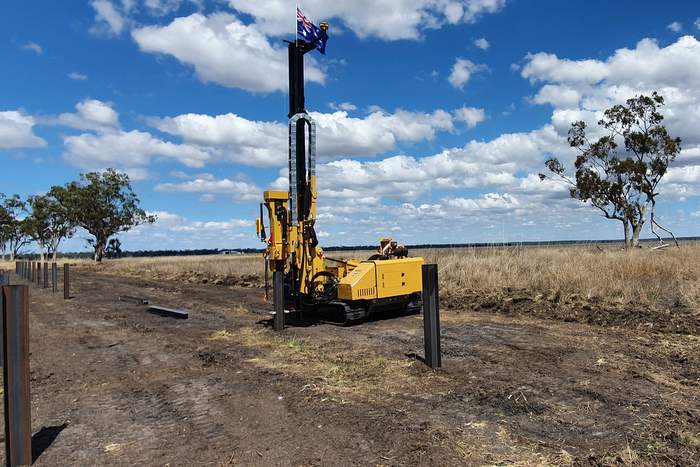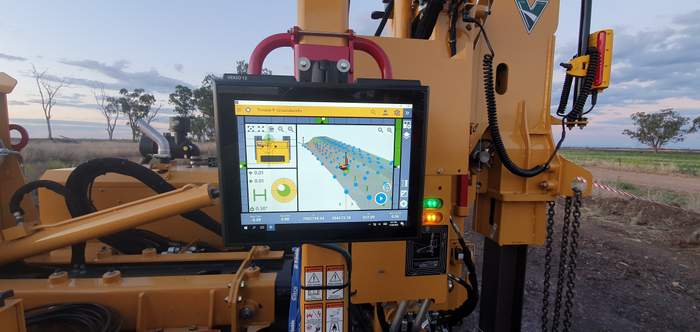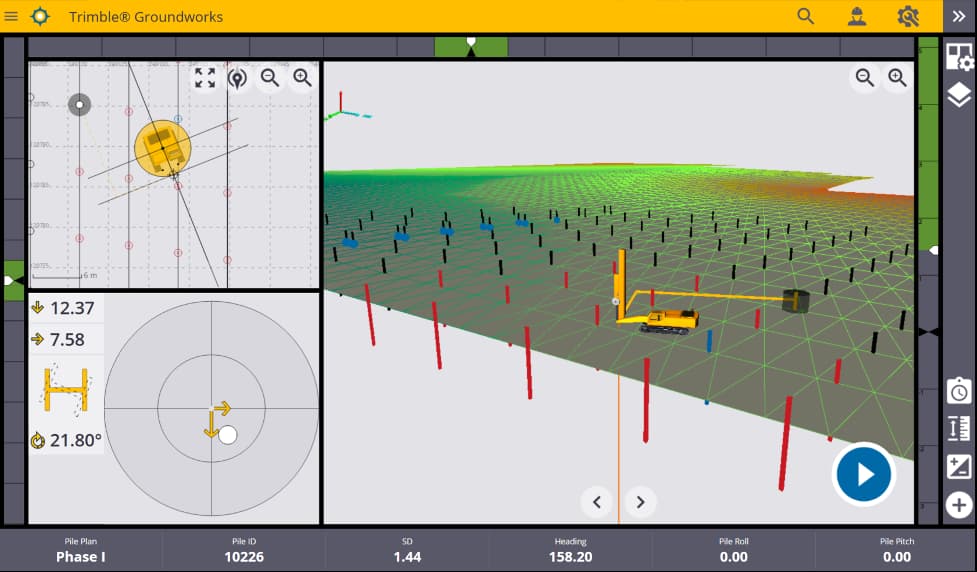
According to the SEIA Solar Market Insight Report 2020 Q3, utility PV development has reached a new milestone with more than 50 GWdc now in operation. Further, the report notes that at the current growth rate, that number is likely to reach 100 GWdc by 2023 and exceed 250 GWdc by 2030—assuming sufficient investment is available and the construction community can keep up. While investment is for another discussion, utility solar farm construction productivity and efficiency is undergoing an impressive technological transformation.
To facilitate growing demand and meet ever tighter timelines, EPC contractors are adopting proven technology capabilities from other machine control workflows to optimize construction workflows. For instance, 3D machine-guidance and machine-control systems on graders, excavators and dozers are already helping these contractors improve productivity, accuracy and safety.
Now, similar systems are available for utility solar farm construction, specifically onto piling machines, that drive the value of data across the construction continuum.
The 3D Advantage
The nature of utility scale solar farm construction is repetitive —conduct a site survey, develop a plan, install piles, posts and panels, and repeat. However, the process requires consistency and accuracy to ensure the panels can move freely, sit at the right height for optimal visibility and minimize wasted space. Accuracy can also be an issue. Pile rework to correct misalignments can add up to significant cost and time.
Over the last 5 years, leading contractors have begun to test and deploy more automated 3D-enabled pile driving approaches with impressive results.
For instance, several years ago, TerraSmart, a utility scale solar solution provider, teamed with SITECH Nevada to equip five drill rigs with the full 3D Trimble Drilling System as a way to install thousands of solar panel rack ground screws in rocky ground with speed and accuracy.
In just four months with the Trimble-enabled rigs, crews drilled more than 62,000 holes and completed the rock drilling portion of the process 50% faster than traditional methods. The team has also improved the accuracy of the drilling over time, fine tuning the entire system to work with ground conditions, allowing crews to maintain holes within ½-inch tolerance.
Further, the TerraSmart team used the Trimble SPS930 Universal Robotic Total Station, the team set the mounting legs to match the elevation change of the ground. Using this system, TerraSmart crews were able to adhere to the height, placement and 1% angle break between leg tolerances required by the general contractor.
On a more recent project, McCarthy Building Companies teamed with Trimble and Tennessee-based SITECH Tri-Rivers to install Trimble’s Piling System on a GAYK Hydraulic Ram piling machine to support a 400-acre utility-scale solar field project in Millington, Tennessee. The team used Trimble Business Center to process and prepare geospatial data so it can be read by the piling system. The pile plan included pile length, elevation, required embedment depth and alignments. Once exported to the Trimble system, the plans were visible by the operators from the on-board displays to facilitate drilling. Operators were also able to view completed piles compared against planned piles in both 2D and 3D views.
Using this 3D machine-guided approach, the contractor reduced the labor required for prep and pile installation by more than 50%, reduced the crew required from 12 people to a crew of three or four people. Notably, crews were also able to install piles about 10% faster but with greater accuracy, keeping pace with an aggressive schedule of three months, even with delays due to rain, snow, extreme heat or cold. The engineering team noticed that overall, piles were placed more accurately as compared to manual methods. Lessons learned from this one project are setting the foundation for future work processes on additional solar projects.
Along with industry applications, 3D guidance features and functionality continue to expand as well.
Connected and Controlled
3D guided piling solutions are designed to withstand shock and vibration of drilling machines, and for ease-of-use with large touch screens and icons, streamlined workflows and visible screens, even in bright sunlight. Connectivity is also particularly important. As solar scale utility farms are often in remote locations, integrated office and field solutions are a necessity for efficiency.
Features and functionality create opportunities for greater efficiency and accuracy. For instance, Trimble Groundworks 3D guided solutions provide mast tilt and drill depth control with auto-stop on the target elevation so that piles are drilled to the exact depth specified.
The value of 3D guided piling on utility scale PV sites has been proven, and will be an essential part of the process as contractors strive to meet the anticipated additional developments in the next five years.
Brian Choi is Civil Engineering Specialty Construction Product Manager at Trimble.
— Solar Builder magazine



Leave a Reply
You must be logged in to post a comment.